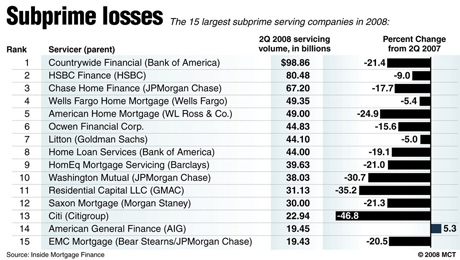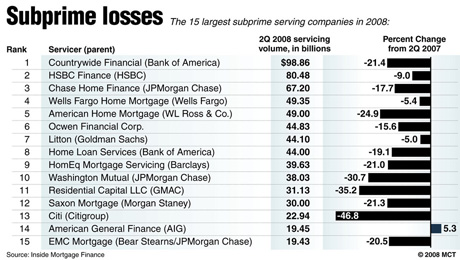
Washington – As the economy worsens and Election Day approaches, a conservative campaign that blames the global financial crisis on a government push to make housing more affordable to lower-class Americans has taken off on talk radio and e-mail.
Commentators say that's what triggered the stock market meltdown and the freeze on credit. They've specifically targeted the mortgage finance giants Fannie Mae and Freddie Mac, which the federal government seized on Sept. 6, contending that lending to poor and minority Americans caused Fannie's and Freddie's financial problems.
Federal housing data reveal that the charges aren't true, and that the private sector, not the government or government-backed companies, was behind the soaring subprime lending at the core of the crisis.
Subprime lending offered high-cost loans to the weakest borrowers during the housing boom that lasted from 2001 to 2007. Subprime lending was at its height from 2004 to 2006.
Federal Reserve Board data show that:
- More than 84 percent of the subprime mortgages in 2006 were issued by private lending institutions.
- Private firms made nearly 83 percent of the subprime loans to low- and moderate-income borrowers that year.
- Only one of the top 25 subprime lenders in 2006 was directly subject to the housing law that's being lambasted by conservative critics.
The “turmoil in financial markets clearly was triggered by a dramatic weakening of underwriting standards for U.S. subprime mortgages, beginning in late 2004 and extending into 2007,” the President's Working Group on Financial Markets reported Friday.
Conservative critics claim that the Clinton administration pushed Fannie Mae and Freddie Mac to make home ownership more available to riskier borrowers with little concern for their ability to pay the mortgages.
“I don't remember a clarion call that said Fannie and Freddie are a disaster. Loaning to minorities and risky folks is a disaster,” said Neil Cavuto of Fox News.
Fannie, the Federal National Mortgage Association, and Freddie, the Federal Home Loan Mortgage Corp., don't lend money, to minorities or anyone else, however. They purchase loans from the private lenders who actually underwrite the loans.
It's a process called securitization, and by passing on the loans, banks have more capital on hand so they can lend even more.
This much is true. In an effort to promote affordable home ownership for minorities and rural whites, the Department of Housing and Urban Development set targets for Fannie and Freddie in 1992 to purchase low-income loans for sale into the secondary market that eventually reached this number: 52 percent of loans given to low-to moderate-income families.
To be sure, encouraging lower-income Americans to become homeowners gave unsophisticated borrowers and unscrupulous lenders and mortgage brokers more chances to turn dreams of homeownership in nightmares.
But these loans, and those to low- and moderate-income families represent a small portion of overall lending. And at the height of the housing boom in 2005 and 2006, Republicans and their party's standard bearer, President Bush, didn't criticize any sort of lending, frequently boasting that they were presiding over the highest-ever rates of U.S. homeownership.
Between 2004 and 2006, when subprime lending was exploding, Fannie and Freddie went from holding a high of 48 percent of the subprime loans that were sold into the secondary market to holding about 24 percent, according to data from Inside Mortgage Finance, a specialty publication. One reason is that Fannie and Freddie were subject to tougher standards than many of the unregulated players in the private sector who weakened lending standards, most of whom have gone bankrupt or are now in deep trouble.
During those same explosive three years, private investment banks — not Fannie and Freddie — dominated the mortgage loans that were packaged and sold into the secondary mortgage market. In 2005 and 2006, the private sector securitized almost two thirds of all U.S. mortgages, supplanting Fannie and Freddie, according to a number of specialty publications that track this data.
In 1999, the year many critics charge that the Clinton administration pressured Fannie and Freddie, the private sector sold into the secondary market just 18 percent of all mortgages.
Fueled by low interest rates and cheap credit, home prices between 2001 and 2007 galloped beyond anything ever seen, and that fueled demand for mortgage-backed securities, the technical term for mortgages that are sold to a company, usually an investment bank, which then pools and sells them into the secondary mortgage market.
About 70 percent of all U.S. mortgages are in this secondary mortgage market, according to the Federal Reserve.
Conservative critics also blame the subprime lending mess on the Community Reinvestment Act, a 31-year-old law aimed at freeing credit for underserved neighborhoods.
Congress created the CRA in 1977 to reverse years of redlining and other restrictive banking practices that locked the poor, and especially minorities, out of homeownership and the tax breaks and wealth creation it affords. The CRA requires federally regulated and insured financial institutions to show that they're lending and investing in their communities.
Conservative columnist Charles Krauthammer wrote recently that while the goal of the CRA was admirable, “it led to tremendous pressure on Fannie Mae and Freddie Mac — who in turn pressured banks and other lenders — to extend mortgages to people who were borrowing over their heads. That's called subprime lending. It lies at the root of our current calamity.”
Fannie and Freddie, however, didn't pressure lenders to sell them more loans; they struggled to keep pace with their private sector competitors. In fact, their regulator, the Office of Federal Housing Enterprise Oversight, imposed new restrictions in 2006 that led to Fannie and Freddie losing even more market share in the booming subprime market.
What's more, only commercial banks and thrifts must follow CRA rules. The investment banks don't, nor did the now-bankrupt non-bank lenders such as New Century Financial Corp. and Ameriquest that underwrote most of the subprime loans.
These private non-bank lenders enjoyed a regulatory gap, allowing them to be regulated by 50 different state banking supervisors instead of the federal government. And mortgage brokers, who also weren't subject to federal regulation or the CRA, originated most of the subprime loans.
In a speech last March, Janet Yellen, the president of the Federal Reserve Bank of San Francisco, debunked the notion that the push for affordable housing created today's problems.
“Most of the loans made by depository institutions examined under the CRA have not been higher-priced loans,” she said. “The CRA has increased the volume of responsible lending to low- and moderate-income households.”
In a book on the sub-prime lending collapse published in June 2007, the late Federal Reserve Governor Ed Gramlich wrote that only one-third of all CRA loans had interest rates high enough to be considered sub-prime and that to the pleasant surprise of commercial banks there were low default rates. Banks that participated in CRA lending had found, he wrote, “that this new lending is good business.”
Truthout has licensed this content. It may not be reproduced by any other source and is not covered by our Creative Commons license.
Join us in defending the truth before it’s too late
The future of independent journalism is uncertain, and the consequences of losing it are too grave to ignore. To ensure Truthout remains safe, strong, and free, we need to raise $43,000 in the next 6 days. Every dollar raised goes directly toward the costs of producing news you can trust.
Please give what you can — because by supporting us with a tax-deductible donation, you’re not just preserving a source of news, you’re helping to safeguard what’s left of our democracy.
